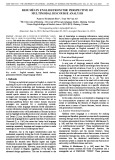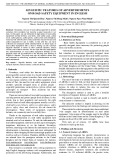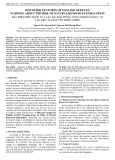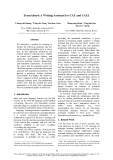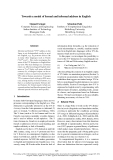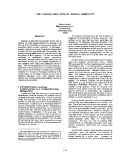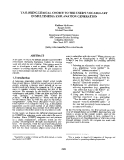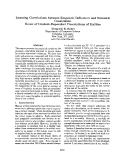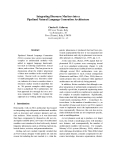
Lexical choices
-
This article aimsto discover discourse features of resumés in English from the perspective of Multimodal Discourse Analysis (MDA). It focuses on describing layout features, lexical choices, grammar features and the image-language relations in 50 English resumés based on the qualitative method.
 6p
6p  vigojek
vigojek
 02-02-2024
02-02-2024
 5
5
 1
1
 Download
Download
-
This paper is aimed at identifying and examining linguistic features of English texts introducing transport services (ETITSs). The research is conducted based on a combination of various methods such as descriptive, analytic and inductive ones.
 5p
5p  vijaguar
vijaguar
 16-11-2022
16-11-2022
 20
20
 4
4
 Download
Download
-
In this paper, we are interested in eight types of road safety equipment namely helmets, seat belts, child safety seats, safety vests, safety glasses, safety gloves, safety shoes and emergency motor/car kits with the aim to help customers choose the best and safest equipment for use in traffic.
 4p
4p  vijaguar
vijaguar
 16-11-2022
16-11-2022
 26
26
 4
4
 Download
Download
-
This study presents an investigation into English Articles Warning about the Risks of Natural Resources Exhaustion (EAWREs). There have been a good number of research works on discourse of environmental issues; however, it is found that there have been few studies on discourse analysis of natural resources warnings.
 4p
4p  vispyker
vispyker
 16-11-2022
16-11-2022
 8
8
 3
3
 Download
Download
-
must pay great attention to choice of words in narrations of trailers. This paper is aimed at examining the striking lexical choices employed in the transcriptions of narrations of American cartoon trailers (NACTs). These cartoons cover a variety of themes which are love and sacrifice, youth and beauty, friendship, nature’s beauty, adventures, science fiction, etc.
 6p
6p  vispyker
vispyker
 16-11-2022
16-11-2022
 13
13
 5
5
 Download
Download
-
Để rèn luyện thêm từ vựng, học sinh có thể làm các chương từ I đến V ( Multiple choice Tests, Lexical Core Tests, open close Tests, Word fornation và Trios of Gapped Sentences). Các chương VI (Sentence Completion). VII (Sentence transformation) và VIII (Error Correction) dùng cho việc rèn luyện kĩ năng nhận biết cấu trúc câu.
 129p
129p  vitsunade2711
vitsunade2711
 02-06-2020
02-06-2020
 74
74
 14
14
 Download
Download
-
In natural language generation (NLG), a semantic representation of some k i n d - possibly enriched with pragmatic attributes - - is successively transformed into one or more linguistic utterances. No matter what particular architecture is chosen to organize this process, one of the crucial decisions to be made is lexicalization: selecting words that adequately express the content that is to be communicated and, if represented, the intentions and attitudes of the speaker.
 7p
7p  buncha_1
buncha_1
 08-05-2013
08-05-2013
 46
46
 1
1
 Download
Download
-
Substantial formal grammatical and lexical resources exist in various NLP systems and in the form of textbook specifications. In the present paper we report on experimental results obtained in manual, semi-antomatic and automatic migration of entire computational or textbook descriptions (as opposed to a more informal reuse of ideas or the design of a single "polytheoretic" representation) from a variety of formalisms into the ALEP formalism.
 9p
9p  buncha_1
buncha_1
 08-05-2013
08-05-2013
 49
49
 1
1
 Download
Download
-
This paper presents a partial solution to a component of the problem of lexical choice: choosing the synonym most typical, or expected, in context. We apply a new statistical approach to representing the context of a word through lexical co-occurrence networks. The implementation was trained and evaluated on a large corpus, and results show that the inclusion of second-order co-occurrence relations improves the performance of our implemented lexical choice program.
 3p
3p  bunthai_1
bunthai_1
 06-05-2013
06-05-2013
 61
61
 3
3
 Download
Download
-
We present an algorithm for simultaneously constructing both the syntax and semantics of a sentence using a Lexicalized Tree Adjoining Grammar (LTAG). This approach captures naturally and elegantly the interaction between pragmatic and syntactic constraints on descriptions in a sentence, and the inferential interactions between multiple descriptions in a sentence. At the same time, it exploits linguistically motivated, declarative specifications of the discourse functions of syntactic constructions to make contextually appropriate syntactic choices. ...
 8p
8p  bunthai_1
bunthai_1
 06-05-2013
06-05-2013
 46
46
 3
3
 Download
Download
-
We introduce a method for learning to predict the following grammar and text of the ongoing translation given a source text. In our approach, predictions are offered aimed at reducing users’ burden on lexical and grammar choices, and improving productivity. The method involves learning syntactic phraseology and translation equivalents. At run-time, the source and its translation prefix are sliced into ngrams to generate subsequent grammar and translation predictions.
 4p
4p  bunthai_1
bunthai_1
 06-05-2013
06-05-2013
 36
36
 3
3
 Download
Download
-
Informal and formal (“T/V”) address in dialogue is not distinguished overtly in modern English, e.g. by pronoun choice like in many other languages such as French (“tu”/“vous”). Our study investigates the status of the T/V distinction in English literary texts. Our main findings are: (a) human raters can label monolingual English utterances as T or V fairly well, given sufficient context; (b), a bilingual corpus can be exploited to induce a supervised classifier for T/V without human annotation.
 11p
11p  bunthai_1
bunthai_1
 06-05-2013
06-05-2013
 58
58
 3
3
 Download
Download
-
Theodes of semantic interpretation which wish to capture as many generalizations as possible must face up to the manifoldly ambiguous and contextually dependent nature of word meaning? In this paper I present a two-level scheme of semantic interpretation in which the first level deals with the semantic consequences of'syntactic structure and the second with the choice of word meaning.
 7p
7p  bungio_1
bungio_1
 03-05-2013
03-05-2013
 37
37
 2
2
 Download
Download
-
which the best lexical choices and the conceptual decisions are in conflict. To prove our theoritical points, we will take as an example the generation of situations involving a result causation, i.e., a new STATE which arises because of one (or several) prior ACTs (Schank 1975).
 4p
4p  bungio_1
bungio_1
 03-05-2013
03-05-2013
 41
41
 1
1
 Download
Download
-
In this paper, we discuss the different strategies used in COMET (COordinated Multimedia Explanation Testbed) for selecting words with which the user is familiar. When pictures cannot be used to disambiguate a word or phrase, COMET has four strategies for avoiding unknown words. We give examples for each of these strategies and show how they are implementedin COMET.
 9p
9p  bunmoc_1
bunmoc_1
 20-04-2013
20-04-2013
 17
17
 3
3
 Download
Download
-
Much effort has been put into computational lexicons over the years, and most systems give much room to (lexical) semantic data. However, in these systems, the effort put on the study and representation of lexical items to express the underlying continuum existing in 1) language vagueness and polysemy, and 2) language gaps and mismatches, has remained embryonic.
 7p
7p  bunrieu_1
bunrieu_1
 18-04-2013
18-04-2013
 38
38
 3
3
 Download
Download
-
This paper presents the results of a s t u d y on the semantic constraints imposed on lexical choice by certain contextual indicators. We show how such indicators are computed and how correlations between them and the choice of a noun phrase description of a named entity can be automatically established using supervised learning. Based on this correlation, we have developed a technique for automatic lexical choice of descriptions of entities in text generation.
 7p
7p  bunrieu_1
bunrieu_1
 18-04-2013
18-04-2013
 52
52
 2
2
 Download
Download
-
A lexicon is an essential component in a generation system but few efforts have been made to build a rich, large-scale lexicon and make it reusable for different generation applications. In this paper, we describe our work to build such a lexicon by combining multiple, heterogeneous linguistic resources which have been developed for other purposes. Novel transformation and integration of resources is required to reuse them for generation.
 7p
7p  bunrieu_1
bunrieu_1
 18-04-2013
18-04-2013
 35
35
 2
2
 Download
Download
-
Pipelined Natural Language Generation (NLG) systems have grown increasingly complex as architectural modules were added to support language functionalities such as referring expressions, lexical choice, and revision. This has given rise to discussions about the relative placement of these new modules in the overall architecture. Recent work on another aspect of multi-paragraph text, discourse markers, indicates it is time to consider where a discourse marker insertion algorithm fits in.
 8p
8p  bunbo_1
bunbo_1
 17-04-2013
17-04-2013
 40
40
 1
1
 Download
Download
-
The EM clustering algorithm (Hofmann and Puzicha, 1998) used here is an unsupervised machine learning algorithm that has been applied in many NLP tasks, such as inducing a semantically labeled lexicon and determining lexical choice in machine translation (Rooth et al., 1998), automatic acquisition of verb semantic classes (Schulte im Walde, 2000) and automatic semantic labeling (Gildea and Jurafsky, 2002).
 8p
8p  bunbo_1
bunbo_1
 17-04-2013
17-04-2013
 42
42
 1
1
 Download
Download
CHỦ ĐỀ BẠN MUỐN TÌM








